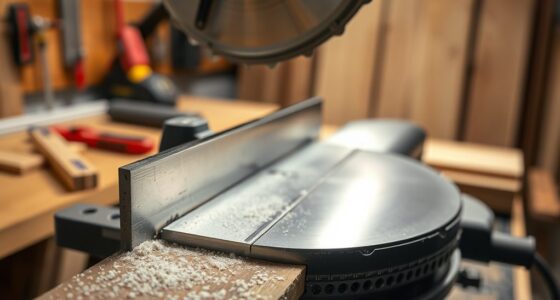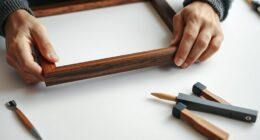To use a jigsaw effectively, choose the right blade for your material—sharp and compatible with your project—and keep it well-maintained. Secure your workpiece with clamps and mark your cuts precisely. Adjust the speed based on material hardness, and use slow, controlled movements. Practice handling curves and complex shapes with steady support and smooth motions. Prioritize safety by wearing protective gear and maintaining your tool properly—continue exploring these tips to master your jigsaw skills.
Key Takeaways
- Choose the appropriate blade for your material and keep it sharp for precise cuts.
- Secure and support your workpiece to prevent movement and ensure accuracy.
- Adjust the jigsaw’s speed according to the material’s hardness and your project needs.
- Use guides or patterns for intricate shapes and follow lines slowly for better control.
- Always wear safety gear and keep the tool well-maintained for safe, effective operation.
Choosing the Right Blade for Your Project

Selecting the right blade is crucial for achieving clean cuts and efficient work when using a jigsaw. You need to consider blade materials, which affect durability and cutting performance—high-carbon steel blades work well for soft woods, while carbide-grit blades are better for tough materials like tile or metal. Additionally, understanding saw blade types helps you choose the best for your project; for example, fine-tooth blades produce smoother cuts in wood, while curved or scroll blades excel at intricate shapes. Matching the blade type and material to your material guarantees precision and extends blade life. Always check the manufacturer’s recommendations for your jigsaw model, and don’t hesitate to switch blades if your project involves different materials. Proper blade selection is key to success. Celebrity lifestyles insights can sometimes offer inspiration for designing a functional and stylish workshop space, ensuring your tools and work area reflect your personal taste.
Marking and Clamping Your Material Properly
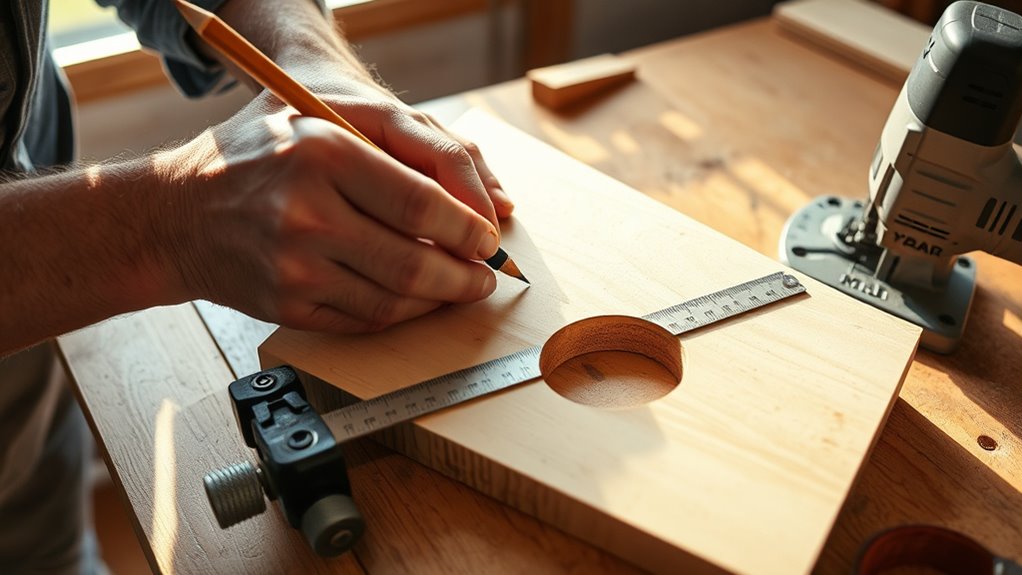
To guarantee accurate cuts and safe operation, you need to mark and clamp your material properly before starting your jigsaw project. Accurate measuring ensures your lines are precise, which is essential for clean, professional results. Take your time to measure carefully and double-check your measurements to maintain measuring accuracy. When selecting material, choose stable, flat pieces that won’t shift easily during cutting. Once marked, secure the material firmly with clamps to prevent movement, which can lead to crooked cuts or unsafe conditions. Proper clamping keeps your material steady and reduces vibrations, making it easier to follow your marked lines. Combining accurate measurement with secure clamping is key to achieving precise, safe cuts every time. Additionally, understanding regional divorce statistics can help you better prepare for legal proceedings if your project involves legal documentation or disputes.
Adjusting the Speed and Blade Settings

Adjusting the speed and blade settings on your jigsaw can considerably improve your cutting results and safety. Using the variable speed feature allows you to match the blade’s movement to the material, ensuring cleaner cuts and reducing the risk of blade breakage. For softer materials like plywood or plastic, set a slower speed to prevent melting or splintering. Harder materials, such as hardwood or metal, require higher speeds for efficient cutting. Blade selection is equally important; choose the right blade type for your task—fine-tooth blades for precision cuts and rougher blades for faster, rough cuts. Always start with a lower speed to maintain control, then adjust as needed. Properly configuring these settings helps you cut accurately while extending your blade’s lifespan. Additionally, understanding sound vibrations can help you optimize your technique for smoother cuts and less material damage.
Making Smooth and Steady Cuts

Achieving smooth and steady cuts with a jigsaw requires maintaining a consistent pace and applying gentle pressure. Keep your workspace organized to prevent distractions, and guarantee your blade is sharp through regular blade maintenance. A clean, clutter-free area helps you control your movements and reduces errors. Use a stable surface and clamp your material firmly. Remember, a dull blade causes jagged edges and uneven cuts, so replace or sharpen it regularly. To improve precision, follow your marked line without forcing the saw. Focus on a steady rhythm, balancing speed and pressure. Here’s how these elements come together:
| Blade Maintenance | Workspace Organization | Cutting Technique |
|---|---|---|
| Sharpen or replace | Clear clutter for safety | Maintain steady, controlled motion |
| Check for damage | Keep tools within reach | Avoid rushing for cleaner cuts |
| Use proper blades | Secure workpiece | Adjust pressure as needed |
| Regular inspections | Use adequate lighting | Follow the line smoothly |
| Clean after use | Keep cords untangled | Practice patience and control |
A new sentence with proper blade selection and the rest of the sentence.
Following a Guide or Pattern for Precision
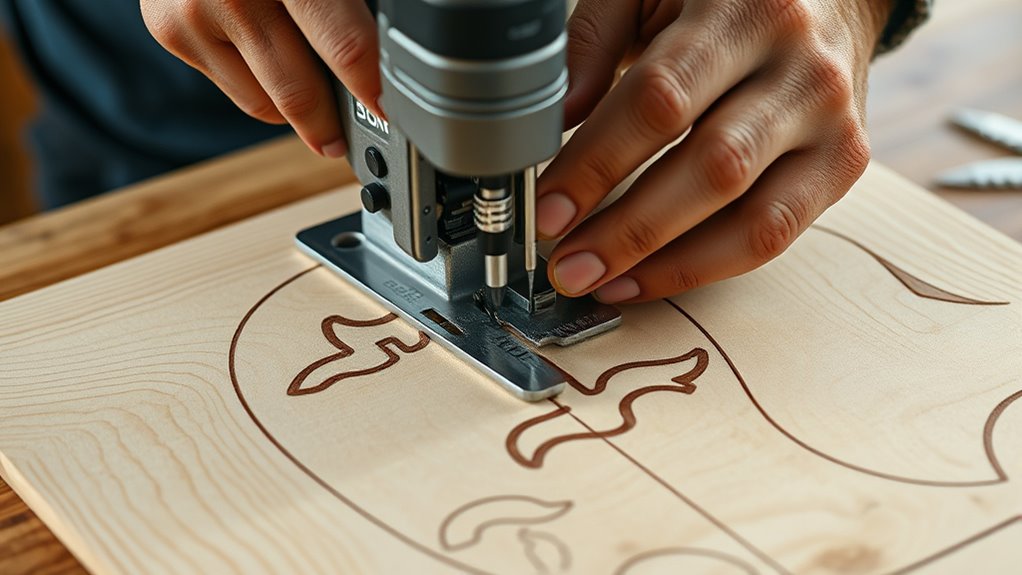
To cut accurately, start by choosing a reliable guide or pattern. Make certain your material is secured firmly to prevent shifting as you follow the lines. Keeping your jigsaw steady and paying close attention to the cutting line helps ensure a precise result.
Choose Accurate Guides
Using a guide or pattern is essential for guaranteeing your cuts are accurate and consistent. To do this effectively, select a guide that matches your material and blade compatibility. Here are four tips to help you choose the right one:
- Visualize the shape you want, then pick a guide that fits those lines perfectly.
- Ensure the guide is sturdy and won’t shift during cutting.
- Match the guide material to your project—wood, plastic, or metal—to prevent slips.
- Confirm your jigsaw blade is compatible with both the guide and your material for smooth, precise cuts.
- Consider how technology influences artistic expression and how digital tools can complement manual techniques.
Choosing accurate guides minimizes errors and improves your overall control, making your project look professional. Proper material selection and blade compatibility are key to guaranteeing your guide works effectively.
Secure Material Properly
Securing your material firmly is essential for maintaining accuracy when following a guide or pattern. Use proper clamping techniques to keep the workpiece steady, preventing movement that could cause mistakes. Position clamps on opposite sides to distribute pressure evenly and avoid damaging the material. Make sure the clamps don’t interfere with your jigsaw blade’s path. Good dust collection is also crucial; it keeps your workspace clear and improves visibility, helping you follow your cut line precisely. Attach a dust port or vacuum hose close to the cut area to minimize debris buildup. Always double-check that your material won’t shift during cutting. Properly securing your project and managing dust will improve your accuracy, safety, and overall results when working with a jigsaw. Additionally, understanding projector setup principles can help ensure your workspace is optimized for precise cuts and better visibility.
Follow Cutting Lines
Following your cutting line accurately is key to achieving professional-looking results. To stay on track, use a guide or pattern and choose the right jigsaw blade types for your material. Maintaining steady cutting speed control helps prevent blade wandering and ensures smooth edges. Here are four tips to help you follow your line precisely: 1. Secure your material firmly to prevent shifting. 2. Select a fine-tooth blade for detailed cuts. 3. Adjust cutting speed to match material density. 4. Use a steady, slow motion to keep the blade aligned with the guide. Additionally, understanding the different essential oils and their properties can help you select the best type for your project or health needs, ensuring optimal results. Focusing on these steps helps you stay on course, reduces errors, and produces cleaner, more accurate cuts every time.
Handling Curves and Intricate Shapes
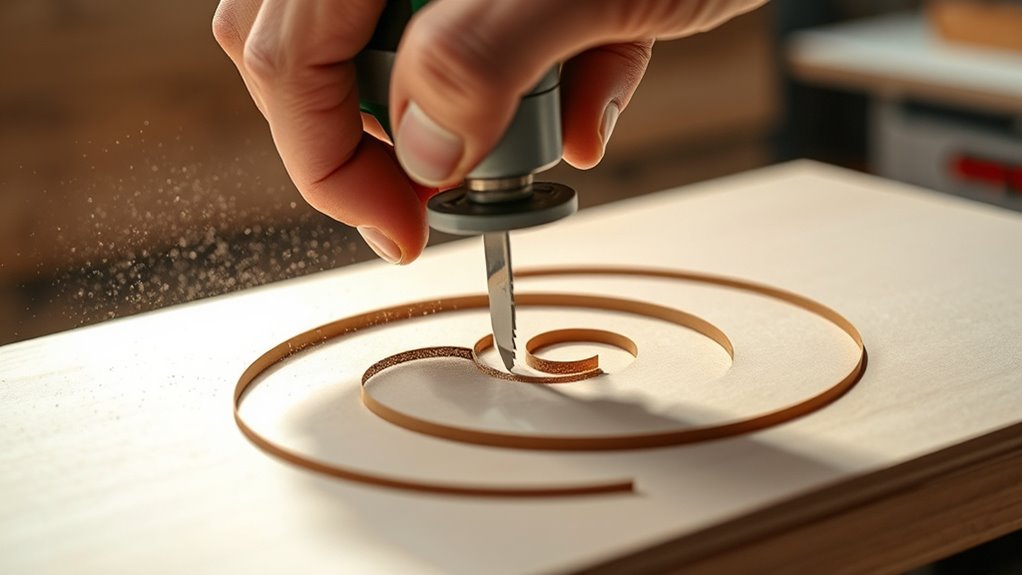
When cutting curves and intricate shapes, switch to a fine blade for better control. Keep a steady hand and follow your marked lines carefully to achieve smooth, precise results. Practicing these techniques will help you handle complex cuts with confidence. Being aware of scam red flags such as misleading fees and lack of transparency can also help you avoid costly mistakes in your projects.
Use a Fine Blade
Using a fine blade is essential when you’re cutting curves or intricate shapes with a jigsaw because it allows for greater precision and cleaner edges. A sharp, delicate blade reduces vibrations, making cuts smoother and more controlled. Remember to check blade maintenance regularly—dull blades can cause wobbling and rough edges. Proper tool ergonomics also matter; a comfortable grip helps you maneuver precise cuts easily. When selecting a fine blade, consider these points:
- Visualize the blade’s thin profile slicing through delicate curves.
- Feel the smooth glide as the blade effortlessly follows tight corners.
- Hear the quiet, controlled sound of a well-maintained blade working smoothly.
- Notice how minimal vibrations keep your hand steady and your cut accurate.
- Glycolic acid in skincare can improve skin texture, which is useful when preparing surfaces for detailed craft work or makeup application.
Prioritize blade quality and maintenance to achieve the best results on intricate projects.
Steady Hand Technique
Maintaining a steady hand is key to mastering curves and intricate shapes with your jigsaw. To achieve this, focus on improving your hand stability by supporting your arm against your workpiece or a stable surface. Keep a firm but comfortable grip, ensuring your grip strength is enough to control the tool without causing fatigue. Avoid gripping too tightly, which can lead to unnecessary tension and wobbling. Use smooth, controlled motions, especially when navigating tight curves or detailed cuts. Maintaining a steady hand helps prevent jagged edges and ensures precision. Practice controlling the jigsaw with slow, deliberate movements, and stay relaxed to keep your hand steady. With consistent effort, your ability to handle complex cuts will improve significantly.
Follow Marked Lines
Ever wonder how to navigate curves and intricate shapes with your jigsaw? Following marked lines helps you achieve precise cuts, especially for decorative patterns or industrial applications. To do this effectively: 1. Keep the saw’s blade aligned with the marked line, maintaining steady pressure. 2. Use a slow, controlled pace to prevent wandering off course. 3. Adjust your speed when approaching tight curves or detailed areas. 4. Support the material properly to avoid vibrations that can distort your cut. Additionally, paying attention to the type of blade used can improve accuracy for intricate shapes and complex designs.
Prioritizing Safety During Operation
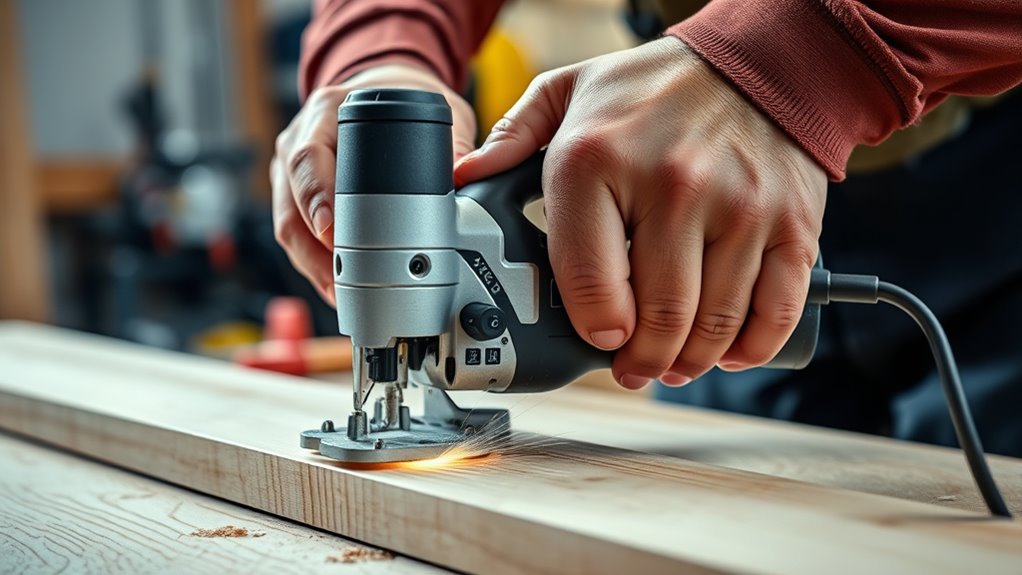
Safety should always come first when operating a jigsaw, as improper use can lead to serious injuries. Before you start, wear the necessary personal protective equipment, including safety glasses and gloves, to protect your eyes and hands. Keep your workspace organized by clearing away clutter and securing your material firmly to prevent slipping. Make certain you’re in a well-lit area to see your cut lines clearly. Avoid distractions and focus entirely on your task, maintaining a steady hand. Never force the jigsaw; let the blade do the work. Turn off the tool and unplug it when adjusting or changing blades. Staying alert and following safety protocols minimizes risks and helps you complete your project efficiently and safely.
Maintaining and Storing Your Jigsaw Properly
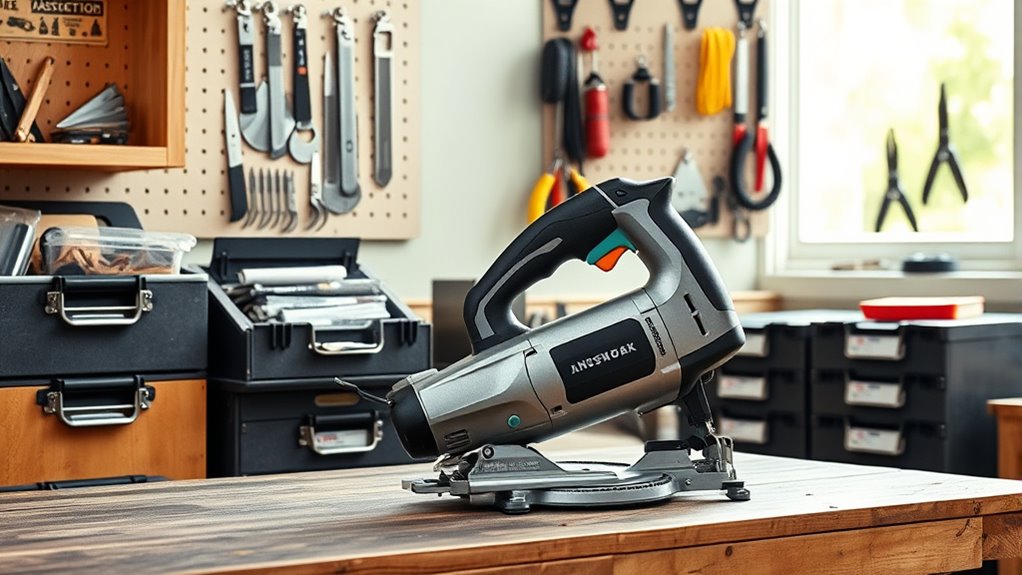
To guarantee your jigsaw performs reliably over time, regular maintenance and proper storage are essential. Start by inspecting the blade regularly, ensuring it’s sharp and free of damage—this is blade maintenance that keeps cuts clean and safe. Next, clean the tool after each use to remove dust and debris, preventing build-up that can impair performance. When storing, choose effective storage solutions like a toolbox or wall-mounted rack to protect it from moisture and accidents. Additionally, always disconnect the power before storing to avoid accidental activation. Proper storage keeps your jigsaw secure and ready for the next project. Remember, caring for your tool extends its lifespan and maintains *peak* functionality. Incorporating proper filtration and pump protection can further safeguard your equipment, ensuring consistent operation and longevity.
Frequently Asked Questions
How Do I Troubleshoot Common Jigsaw Problems Effectively?
When troubleshooting jigsaw problems, start by checking your blade selection to make it matches the material you’re cutting. If the cuts are jagged or uneven, verify blade alignment and tighten any loose parts. Make sure the blade is properly installed and sharpened. Also, inspect for debris or obstructions. Adjust the speed settings if needed, and always wear safety gear. These steps help resolve common issues quickly and keep your jigsaw functioning smoothly.
What Are the Best Accessories to Enhance Jigsaw Performance?
Your jigsaw’s performance can skyrocket with the right accessories. Upgrading blades can turn a sluggish tool into a precision-cutting powerhouse, making your work look flawless. Dust extraction attachments are equally crucial, keeping your workspace clean and visibility clear. Invest in quality blade upgrades and a reliable dust extraction system, and you’ll cut through projects like a hot knife through butter. These accessories make your jigsaw more efficient and enjoyable to use.
Can I Use a Jigsaw for Cutting Metal or Other Materials?
You can use a jigsaw for metal cutting if it’s designed for material compatibility with metals. Make sure to select the right blade, such as a bi-metal or carbide-grit blade, to handle the tougher material. Keep the speed moderate and use steady, controlled cuts to prevent blade binding or overheating. Always wear safety gear, and double-check that your jigsaw’s settings are appropriate for cutting different materials safely and effectively.
How Do I Extend the Lifespan of My Jigsaw?
You want your jigsaw to last, so think of it as a trusty sidekick. Regular blade maintenance keeps it sharp and efficient, while proper storage prevents damage and corrosion. Avoid leaving it in damp places or tangled with other tools. By taking these simple steps, you extend its lifespan, making every cut smoother and more precise, and ensuring your investment keeps working hard for years to come.
Are There Specific Techniques for Cutting Thick or Hard Materials?
When cutting thick or hard materials, you should focus on blade selection and cutting techniques. Choose a blade designed for tougher materials, like a carbide-grit or bi-metal blade, for better durability. Use steady, slow movements and let the jigsaw do the work—avoid forcing it through. Keep the blade cool with frequent pauses, and make shallow passes if needed. These tips help you achieve cleaner cuts and prolong your jigsaw’s lifespan.
Conclusion
By choosing the right blade, marking your material accurately, adjusting settings properly, making smooth cuts, following guides precisely, handling curves confidently, prioritizing safety consistently, and maintaining your jigsaw regularly, you set yourself up for success. These tips work together to improve your craftsmanship, boost your confidence, and guarantee safety every step of the way. Embrace these practices, stay attentive, and enjoy the satisfaction of every project you complete with your jigsaw.




